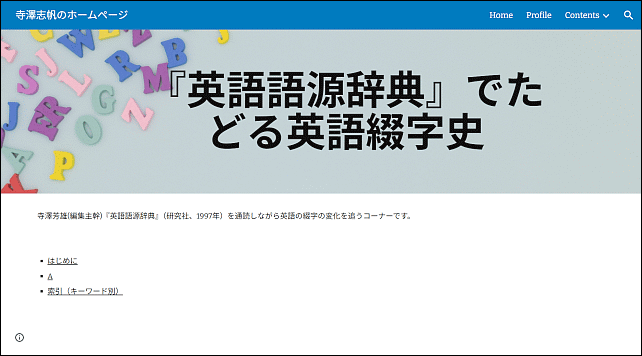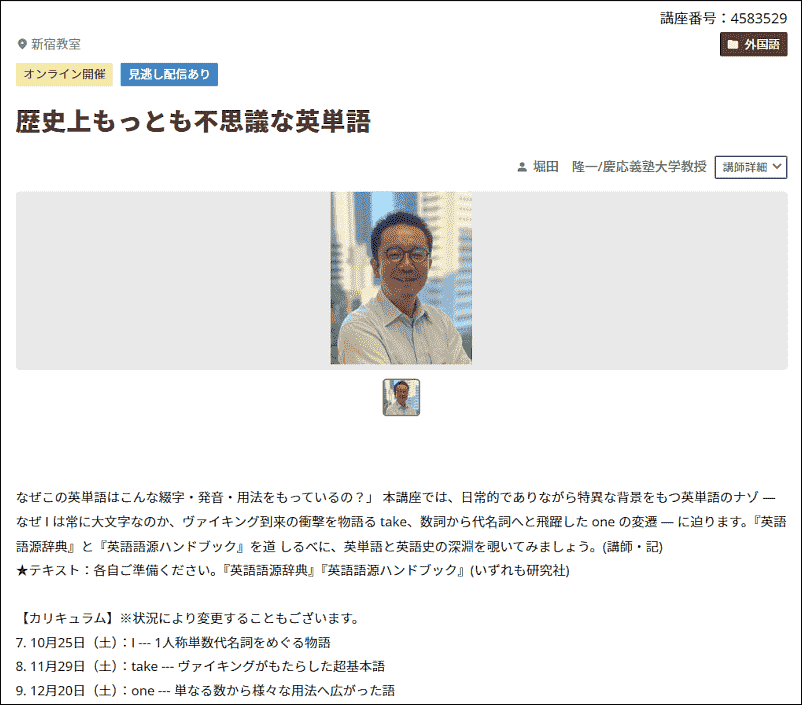2025-12-31 Wed
■ #6092. 「英語に仮名はないのか?」論争 --- mond での問答にまた注目が集まりました [mond][spelling_pronunciation_gap][spelling][orthography][japanese][hiragana][katakana][romaji][writing][grammatology]

12月28日のお昼に,知識共有プラットフォーム mond に投稿したある回答が,X 上で大きな反響を呼んでいます.一晩でインプレッションが100万を超え,本日の朝までに358万に達しています.日英語の文字遣いの差に関する文字論の話題で,一見すると地味なテーマですが,おおいに盛り上がっています.驚きとともに,この分野への潜在的な関心の高さを改めて実感しています.
話題となっているのは,mond に寄せられた1つの質問です.「日本語では,聞いて音が分かったが漢字の表記が分からない場合,とりあえず仮名で書くという方法をとることができますが,英語では綴りが分からないとそもそも書いて残すことができません.音は分かるが綴りが分からないときは,どう対処しているのですか.」という問いです.
これに対する回答で,私は「アルファベットを仮名のように使えばいい」という視点と,「英語のスペリングは漢字のようなものだ」という論を展開しました.
この回答に対し,主に X のリプライを通じて非常に活発な議論が交わされています.しかし,皆さんの反応を見ていて気づかされたのは,この「問い」自体が非常に広く,多義的であるという点です.質問の文言だけでは,具体的にどの場面を想定しているのかが1点に定まりません.だからこそ,皆さんから「自分ならこう答える」という多様な意見が出されているわけです.
この「英語に仮名はないのか?」論争をめぐり論点がやや錯綜してきたので,ここで交通整理したいと思います.質問の意図をなるべく一意に定めるために,少なくとも以下の6つほどのパラメータを考慮する必要があると現時点では考えています.
1. 誰の対処法を尋ねているのか?
A. 英語母語話者(はどう対処していますか?)
B. 日本語母語話者で英語学習者の皆さん(はどう対処していますか?)
2. その綴字の用途は?
A. 後に他人と共有しない前提でのインフォーマルなメモのために
B. 後に他人と共有する前提でのフォーマルな文書のために
3. どこまで正書法にこだわるか? 規範に従うことが重要か,あるいはとりあえず伝達できれば十分か?
A. 原則としてこだわる(単語テスト,学校のレポート,公式文書など)
B. それほどこだわらない(メモ,親しい仲間内での伝言など)
4. 綴字を知りたい当該の単語の種類は?
A. 一般語や地名
B. 人名
5. 単語の発音から正しい綴字にたどり着く方法は?
6. 単語の意味が分かっている,あるいはある程度推測できるか?
文字とは何か,正しさとは何か.この議論の熱を絶やさず,引き続き議論を深めていければと思います.
関連して,29日の午後に,紛糾する議論を受けて heldio にて特別配信回「【152万インプ超え】mond の「英語に仮名はないのか?」論争を交通整理します」を公開しました.
また,30日のお昼には,続編となる mond への回答も投稿しているので,そちらもご覧ください.
2025-11-03 Mon
■ #6034. khelf 寺澤志帆さんの「『英語語源辞典』でたどる英語綴字史」が開始から半年 [khelf][kdee][helkatsu][spelling_pronunciation_gap][terasawashiho][etymological_spelling][spelling][orthography]

khelf の寺澤志帆さんの連載企画「『英語語源辞典』でたどる英語綴字史」が,11月1日に公開された記事「160. anemone ―発音は/ənéməni/―」をもって,開始から丸半年を迎えました(おめでとう!).筆者曰く,
今日で「『英語語源辞典』でたどる英語綴字史」連載から半年が経ちました。気の向くまま(時折休みつつ)地道に続けてきましたが、半年で進んだのはなんと44ページ目まで。1年経過したときにAで始まる語を読み終えているのか、それとも立ち止まりすぎてAからまだ抜け出せていないのか、どうぞ気長にお楽しみください。
いまだ A の項目から抜け出せていない旨が述べられていますが,すでに160を越える英単語語源エッセイが公開されており,連載として安定感が出てきました.英語史的には第一級のおもしろさです.英単語の語源,とりわけ綴字に関心のある方は必読です.定期購読のために RSS フィードも用意されています.
この連載が学術的な価値をもっているのは,信頼のおける『英語語源辞典』(研究社)が基盤にあるからということもありますが,研究者としての寺澤さんの学究的姿勢が現われているからです.常に OED をはじめとする各種の専門的な文献を参照し,「裏取り」をしたり,諸説を比較検討したりするのは,それ自体が学術活動です.
連載開始から1ヶ月ほど経った頃の「34. <c>か<cc>か、それが問題だ! (<acc->を持つ語について)」辺りからは,遊び心ある副題が付くようになっています.その単語に対する筆者の関心の在処がわかり,ぐんと読みやすくなっています.
最近の記事でとても勉強になったのは「158. and ―弱形an―」です.an = "(and) if" の中英語や近代英語からの用例が挙げられており,これは相当に注意を払っていないと読み落としたり読み違えたりする可能性が高いと思いました.記事末尾には「148. ampersand ―&の名前―」への参照もあり,A の項目内にとどまるとはいえ,このようなクロスレファレンスも充実してきています.
寺澤志帆さんの連載「『英語語源辞典』でたどる英語綴字史」については,過去にも hellog や heldio で触れてきました.ぜひこちらもご参照ください.
・ hellog 「#5861. khelf 寺澤志帆さんが「『英語語源辞典』でたどる英語綴字史」シリーズを開始しています」 ([2025-05-14-1])
・ heldio 「#1443. 「『英語語源辞典』でたどる英語綴字史」 by khelf 寺澤志帆さん」
・ heldio 「#1556. khelf 寺澤志帆さんの「『英語語源辞典』でたどる英語綴字史」が好調です --- RSS も用意されています」
・ 寺澤 芳雄(編集主幹) 『英語語源辞典』新装版 研究社,2024年.
2025-10-30 Thu
■ #6030. 「3文字規則」まとめ --- 短い単語に隠された正書法とアイデンティティの問題 [three-letter_rule][orthography][spelling][personal_name][onomastics][sociolinguistics]
本ブログでも何度か取り上げてきた「3文字規則」 (three-letter_rule) についてポイントをまとめます.もっとも基本となる記事は「#2235. 3文字規則」 ([2015-06-10-1])です.
英単語を眺めていると,ごく短い2文字からなるものがいくつかあることに気づきます.an, is, of などです.このような短い語は,いずれも文法的機を帯びた「機能語」 (function word) であり,具体的な意味をもつ名詞や動詞に代表される「内容語」 (content word) ではありません.英語には,機能語は2文字以下の短さが許されるけれども,内容語については必ず3文字以上で綴られなければならないという「3文字規則」 (three-letter_rule) なる珍妙なルールがあります.
繰り返しますが,「3文字規則」が適用されるのは,内容語についてのみです.機能語,すなわち代名詞,助動詞,前置詞,接続詞などに代表される文法機能を担う語で,典型的に頻度がきわめて高い語類については,この規則は適用されません.たとえば,電子メールなどで頻繁に使われる2文字の単語 re (= about) は,頻度が高いものの,機能語であるため「3文字規則」の例外とはみなされません.
では,なぜ内容語は3文字を下限とするのでしょうか.この規則は,単語機能の効率性という実用的な尺度が関わっていると考えられます.一般的に,よく読み書きする単語の綴字は短いほうが効率的です.日常的によく使うわけですから,出番が多く,語形としては短い方に越したことはありません.これは統計的に考えても合理的な方策と言えます.
もちろん「規則」には例外が付きものです.ax (斧), ox (雄牛)のような一般的な例外がすぐに挙がってきますが,ほかにも専門的な例外として Od (ドイツの科学者 K. von Reichenbach が1845年に創成した仮説上の物理学的力)もあります.その他のエキゾチックな語として aa, ai, ba, bo, bu など,ほとんど知られていない例外も挙げられますが,これらの見慣れない例外こそが,むしろ当該規則の一般性を裏付けているとも言えます.
「3文字規則」のパロディと言えるものに,人名に見られる「4文字規則」なるものがあります.人名の綴字には,通常の英単語の正書法に照らせば余分と見なされる文字が含まれることが,しばあります.Anne, Kidd, Locke, Smythe, Webb のような事例です.これは,人名がアイデンティティや存在感を示すための手段であり,視覚的に「盛る」傾向があるためと考えられます.
上記のように,英語の「3文字規則」は,内容語の綴字の下限を定める,実用的な正書法のルールと言えます,一方,人名においては,アイデンティティを強調し,視覚的な存在感を示すために,あえて綴字を長くする「4文字規則」のような副次的な慣習が存在します.
これら2つの規則は,英語の綴字が単なる音の記録ではなく,頻度,効率,視覚性,そして社会的アイデンティティといった多様な要因を組み込んだ記号であることを示唆しているのです.
2025-10-26 Sun
■ #6026. OED にみる1人称代名詞 I の異形 [personal_pronoun][spelling][variation][oed][dialect][punctuation][through][orthography]
本ブログでは,英語史における綴字の多様性について折に触れて取り上げてきた.特に「#53. 後期中英語期の through の綴りは515通り」 ([2009-06-20-1]),「#5738. 516番目の through を見つけました」 ([2025-01-11-1]) で取り上げた through の例は,現代の標準化された正書法に慣れた私たちにとって衝撃的ですらある.
さて,今回は through に勝るとも劣らないであろう,身近な単語の歴史的異形の多さをご紹介したい.1人称単数主格代名詞の I である.現代英語ではアルファベット1文字で表わされるこの代名詞が,歴史上,あるいは方言において,どれほど豊かな姿を見せてきたことか.OED の I (PRONOUN & NOUN2) の項目に掲載されている variant forms のセクションの1部を覗いてみることにしよう.
以下に,時代や地域を考慮せずに集められた I の異形を一覧で示す.その圧倒的な数に驚かれるかもしれない.
α.
(a)
ich (Northumbrian), ih (Northumbrian)
ig (rare)
ic
hic, icc
yc
Hic, Hit (transmission error), hyc, Ic, Icc, ick (northern), Iic, Ik (east midlands and northern), it (transmission error), yg
ik (chiefly east midlands and northern), ike (east midlands and northern), yk
(b) Scottish
ic, ik
β.
(a)
i
Hi, hi, Hy, ij, yi, yj
y
I
a (Yorkshire and Norfolk), e, hij, hy, j, Y
a (regional)
ah (regional), oi (regional)
(b) U.S. regional (chiefly south Midland and southern)
ah, uh
Ah, Hi, Oy, oy, u
(c) English regional
a (chiefly northern and north midlands)
ai (Devon), au (northern and north midlands), aye (Yorkshire), ee (northern), eh (Lancashire), eigh (Yorkshire), ha (Yorkshire), O (Yorkshire)
Aa (northern), aa (northern), Ah (northern and north midlands), ah (northern and north midlands), aw (northern and north midlands), hah (Yorkshire), Oi, oi
A (chiefly northern and north midlands), hi (Worcestershire)
(d) Scottish
i, y
a, I
Aw, aw
A, Aa, Ah, ah, Eh (Dundee), eh (Dundee), ey (Dundee)
(e) Also Irish English
a' (northern)
a (northern), Oi (southern), oi (southern)
A (northern), Ah (northern), ah (northern)
(f) Also Australian
Oi, O'i, oi
γ.
(a)
ich
ch (probably transmission error), Hich, hich, icche, ichc, ichs, icht, ics, Ih, ih, Ihc, ihc, ihic (probably transmission error), iho (transmission error), Iich, iich, yh
ych
Ich, jch, yche
iche
(b) English regional (south-western)
ich
iche (Somerset), ichy (Dorset), ish (Devon), uch, utch, utchy (Somerset)
(c) Irish English (Wexford)
ich
δ.
(a)
his, is
(b) English regional (south-western)
ees (Devon), es, Iss (Devon)
ise, us (Somerset)
Ice (Somerset), is (Cornwall), ize
ε. Chiefly English regional (south-western)
chee
che
しめて以下の98種類の綴字が得られた:A, a, a', Aa, aa, ah, Ah, ai, au, aw, Aw, aye, ch, che, chee, e, ee, ees, eh, Eh, eigh, es, ey, ha, hah, hi, Hi, Hic, hic, Hich, hich, hij, his, Hit, hy, Hy, hyc, i, I, ic, Ic, icc, Icc, icche, Ice, Ich, ich, ichc, iche, ichs, icht, ichy, ick, ics, ig, Ih, ih, Ihc, ihc, ihic, iho, Iic, Iich, iich, ij, ik, Ik, ike, is, ise, ish, Iss, it, ize, j, jch, O, O'i, Oi, oi, Oy, oy, u, uch, uh, us, utch, utchy, y, Y, yc, ych, yche, yg, yh, yi, yj, yk
なお,OED では,この一覧の直前に次の但し書きがついている."(Capitalization in Middle English examples frequently reflects the editorial choices of modern editors of texts, rather than the practice of the manuscripts.)"
写本における実際の大文字・小文字の使い分けまで考慮に入れれば,異形の数はさらに増えるだろう.先に触れた through の516通りには及ばないかもしれないが,それでも,たった1つの機能語が示してきた多様性に驚きを禁じ得ない.人称代名詞 (personal_pronoun) のような基本語ですら,いや基本語だからこそ,その歴史は豊かである.
2025-10-21 Tue
■ #6021. 10月25日(土),朝カル講座の秋期クール第1回「I --- 1人称単数代名詞をめぐる物語」が開講されます [asacul][notice][personal_pronoun][person][case][indo-european][kdee][hee][etymology][sound_change][gvs][spelling][hel_education][helkatsu]

月1回,朝日カルチャーセンター新宿教室で英語史講座を開いています.今年度のシリーズは「歴史上もっとも不思議な英単語」です.英語史的に厚みと含蓄のある英単語を1つ選び,そこから説き起こして,『英語語源辞典』(研究社)や『英語語源ハンドブック』(研究社)等の参考図書の記述を参照しながら,その英単語の歴史,ひいては英語全体の歴史を語ります.
来週末の10月25日(土)の講座は秋期クールの初回となります.今回は,英語において,最も短く身近な単語の1つでありながら,その歴史に壮大な物語を秘めた1人称単数代名詞 I に注目します.誰もが当たり前のように使っているこの単語ですが,少し立ち止まって考えてみると,実に多くの謎に満ちていることに気づかされます.以下,I について思いついた謎をいくつか挙げてみます.
・ 古英語では ic 「イッチ」と発音されていました.これが,いかにして現代の「アイ」という発音に変化したのでしょうか.そもそも語末にあった c の子音はどこへ消えてしまったのでしょう.
・ なぜ I は,文中でも常に大文字で書かれるのでしょうか.
・ なぜ主語は I なのに,目的語にはまったく形の異なる me を用いるのでしょうか.
・ It's me. と It's I. は,どちらが「正しい」のでしょうか.規範文法と実用の観点から考えてみたいと思います.
・ 近年耳にすることも増えた between you and I という表現は文法的にどう説明できるのでしょうか.
・ 翻って日本語には「私」「僕」「俺」など,なぜこれほど多くの1人称代名詞があるのでしょう.英語の歴史と比較することで見えてくるものがありそうです.
このように,たった1文字の単語 I の背後には,音声変化,綴字の慣習,文法規則の変遷,そして語用論的な使い分けといった,英語史u上の重要テーマが凝縮されています.講座では,時間の許す限りなるべく多くの謎に迫っていきたいと思います.
講座への参加方法は,今期よりオンライン参加のみとなります.リアルタイムでの受講のほか,2週間の見逃し配信サービスもあります.皆さんのご都合のよい方法でご参加いただければ幸いです.また,開講時間がこれまでと異なり 15:30--17:00 となっていますので,ご注意ください.講座と申込みの詳細は朝カルの公式ページよりご確認ください.
今度の講座のご紹介は,先日の heldio でも「#1602. 10月25日の朝カル講座は I --- 1人称単数代名詞に注目」としてお話ししましたので,そちらもお聴きください.
なお,秋期クールのラインナップは以下の通りです.皆さんで「英語史の秋」を楽しみましょう!
- 第7回:10月25日(土) 15:30?17:00 「I --- 1人称単数代名詞をめぐる物語」
- 第8回:11月29日(土) 15:30?17:00 「take --- ヴァイキングがもたらした超基本語」
- 第9回:12月20日(土) 15:30?17:00 「one --- 単なる数から様々な用法へ広がった語」
・ 寺澤 芳雄(編集主幹) 『英語語源辞典』新装版 研究社,2024年.
・ 唐澤 一友・小塚 良孝・堀田 隆一(著),福田 一貴・小河 舜(校閲協力) 『英語語源ハンドブック』 研究社,2025年.
2025-10-14 Tue
■ #6014. 表記スペースが足りないときには母音字を捨てる --- 英語史小ネタ from スーパー [writing][spelling][consonant][vowel][abbreviation][alphabet]
New Zealand は Christchurch に着いて2週間弱が経過した.お世話になっているいくつかのスーパーマーケットの1つが,"NZ's Lowest Food Prices" を謳うNZローカルのスーパー PAK'n'SAVE だ.倉庫型の巨大スーパーで,品揃えを眺めて歩くだけでも時間を忘れる.NZ的な野菜・肉・魚はもちろん,日本食材を含めアジアのものも手に入る.日常的なモノほど英語での表現が出てこないものなので,店内を歩き回るのは単純に英語学習によい.
日本食材の棚を眺めていたとき,背後の棚にあるメープルシロップが視界に入った.以下の写真の通りだが,左下のラベルを読んでみると,次のようにある:"PAMS FINEST / MPLE SYRP / CNDIAN A GRD / 250ML" .

ラベルの記入欄が狭いので,綴字を省略せざるを得ない.そこで何を省略するかといえば,典型的に母音字である.子音字は音節の骨格を形成するため,それさえ残せば読み手にとって十分なヒントになるからだ.実際に英語の知識があれば,商品そのものもそこにあるため,頭の中で展開するのは用意だ.フルに展開すると "PAMS FINEST / MAPLE SYRUP /CANADIAN A GRADE / 250ML" となる.
スーパーの英語綴字におけるこのような省略は,アルファベット文化圏では広く見られるものだろう.細かくみれば各言語の音素配列,音節構造,綴字体系に依存するものと思われるが,子音字を残すのが基本である.
この傾向は,文字,とりわけ表音文字の発展の経緯と連動しており意味深長だ.絵文字から発展した表語文字は,少なからぬ文字文化圏において,表音文字へと発展した.表音文字は,まず音節文字から始まるのが普通だ.例えば /ka/ という音節を「か」と仮名1文字で書くような発想だ.このような音節文字は,しばしば母音を無視して子音のみを標示する用法を発達させた.「か」と書いておきながら,これを /k/ という単独の子音として読ませるやり方だ.母音の「読み捨て」である.
ちなみに,アルファベット発達史を眺めても,子音字を重視する姿勢が一貫している.ここには,アルファベットという単音文字が,子音重視の音節構造をもつアフロアジア語族において発生・発達した事実が関係してくるだろう.相対的に母音字は軽視されてきたのである.アルファベット史でよく知られているように,母音字を積極的に「書き救う」動きが出たのは,フェニキア文字からギリシア文字が派生したときだった.以降,ローマ字の展開を経て,広くローマ字文化圏でも,原則として母音字を表記する綴字習慣が根付いた.
メープルシロップの例のように,表記スペースが足りないというやんごとなき事情がある場合に,子音字を残して母音字を捨てるというのは,ある意味で文字史を遡っているかのような現象なのである.振り返ったメープルシロップの棚の前で,(買わずに)アルファベット史3700年を振り返った次第.
2025-09-29 Mon
■ #5999. crocodile の英語史 --- 『シップリー英語語源辞典』の意外な洞察 [voicy][heldio][spelling][metathesis][etymological_spelling][folk_etymology][animal][greek]
crocodile の語形や綴字を巡る問題 --- ワニワニパニック --- は,heldio/helwa コアリスナーの lacolaco さんが火をつけた難問である.関連する一連の話題は,以下から追うことができる.
・ lacolaco さんの「英語語源辞典通読ノート C (crew-crocodile)(2025年7月27日)
・ lacolaco さんの「【helwaコンテンツ2025】 crocodileの語形・音変化についての調査~ワニワニパニック~」(2025年8月21日)
・ hellog 「#5948. crocodile の英語史 --- lacolaco さんからのインスピレーション」 ([2025-08-09-1])
・ hellog 「#5951. crocodile の英語史 --- OED で語源と綴字を確認する」 ([2025-08-12-1])
・ hellog 「#5952. crocodile の英語史 --- MED で綴字を確認する」 ([2025-08-13-1])
・ heldio 「#1527. crocodile の怪 --- lacolaco さんと語源学を語る(プチ英語史ライヴ from 横浜)(2025年8月4日)
・ heldio 「#1583. alligator でワニワニパニック --- khelf 寺澤志帆さんと語る」(2025年9月29日)
とりわけ crocodile の異形として cocodril という語形・綴字があったことが気になっていた.そんなときに,先日『シップリー英語語源辞典』でふと crocodile を引いてみたところ,cocodril の謎に対するヒントとなる記述を見つけた.今回は,それを引用して,示唆だけ与えておきたい.
crocodile [krάkədàil] クロコダイル,ワニ,ワニ皮
この語はギリシア語 krokodeilos (ワニ:〔原義〕砂礫の虫,トカゲ)が語源である.このギリシア語は,ヘロドトス (Herodotus, 484?--425?B.C.) 以来,ナイル川に棲む巨大な爬虫類に使われるようになった.彼の Historiae:『歴史』 (II, 69) には,自国の石垣の間にいるトカゲに似ているところからイオニア人がそう名づけた,とある.crocodile にはいろいろな綴りがあり,その一つ cockadrill は,ワニの点滴とされたコカトリス (cockatrice) と混同されたこともある.
ところで,ワニは生き残ったが,コカトリスは中世の博物誌が衰退するととtもに死に絶えた.cockatrice は,ギリシア語 ikhnos (歩み,足跡)から動詞 ikhneuein (追跡する,足跡を追う)を経て成立した ikhneumon (エジプトマングース --- ichneumon 〔エジプトマングース〕として英語に借入 ---)の訳語としてのラテン語 calcatrix が語源であり,原義は「狩猟者」「追跡者」であった.この動物は砂の中のワニの卵を探し出して食べるとエジプト人に信じられていた.ラテン語 calcatrix は calx, calc- (踵)から派生した動詞 calcare (追跡する)からの造語である〔中略〕.《プリニウス (Gaius Pliny, 23--79) の『博物誌』 (VIII, 37) では,ワニが気持ち良く口を開けて寝ている間にコカトリスはのどから腹に飛び込み,内臓をかみ裂くとある.》
また,コカトリスはナイルチドリ (trochilus) と混同された.こちらの語源は trekhein (走る)から派生したギリシア語 trokhilos (小型シギ類)がラテン語化した言葉で,原義は「素早く走り回るもの」である〔中略〕.crocodile bird (ワニチドリ)とも呼ばれるこの鳥には,ワニの歯の間の肉片や食べ物のかすを突くという言い伝えがある.コカトリス (cockatrice) は想像上では鳥,獣,そして最後には爬虫類とされ,ミズヘビとして描かれる際には,英語の cock (ニワトリ)との類推からニワトリの卵から生まれた怪物バシリスク (basilisk) 〔中略〕と同じと見なされた.これはニワトリのとさかと体に,ヘビの尾を持ち,吐く息やひとにらみで人を殺すとされた.
ひとにらみで殺すというバシリスク (basilisk) は,比喩表現では,女性,特に浮気な女性に使われ,このことから cockatrice にも同じく比喩表現が生まれた.例えば,イギリスの劇作家デッカー (Thomas Dekker, 1572?--1632) の The Guls Hornebooke:『しゃれ者の入門書』(1609年)における一章「劇場における当世風紳士の振る舞い方」に,「(負債を取り立てる)執行吏を避けるためにも,朝早く妖婦 (cockatrice) を船で返すためにも」いっそう便利な水辺の家がお勧め,とある.かくして,この生き物を水に返したことになるが,等の女性はそら涙 (crocodile tears:ワニの涙)を流すだろう.女の「そら涙」にほだされると,「餌食」になってしまうこともある.
見せかけの悲しみを表す crocodile tears は,ワニが餌食を誘き寄せるために悲しげに呻くとか,餌食を飲み込みながら涙を流すと考えられたところから生まれた表現である.
今回登場したのは伝説の動物 cockatrice (コカトリス)だ.ヘビとニワトリが合体した動物とも,にらんだり息を吐きかけて人を殺すヘビとも言われる.これが cocodril の語形・綴字に関係しているというのは,ありそうな話しだ.
・ ジョーゼフ T. シップリー 著,梅田 修・眞方 忠道・穴吹 章子 訳 『シップリー英語語源辞典』 大修館,2009年.
2025-08-13 Wed
■ #5952. crocodile の英語史 --- MED で綴字を確認する [spelling][etymological_spelling][french][loan_word][borrowing][metathesis][me][animal][med]
昨日の記事 ([2025-08-12-1]) に続き crocodile を考える記事.今回は,同語の初出が中英語期なので MED を引いてみることにする.MED では cocodril (n.) として見出しが立てられている(crocodile ではないことに注意).以下,挙げられているすべての用例を再現する.
(a1387) Trev.Higd.(StJ-C H.1)3.109 : A cokedrille..is comounliche twenty cubite long.
(a1398) *Trev.Barth.(Add 27944)154b/a : Emdros is a litil beste..yif þis litil beste fynde a cocodrill slepyng, he..comeþ in atte þe mowthe in to þe cocodrill and in his wombe, and alto renteþ his guttes inward and sleeþ him, and dyeþ so.
(a1398) *Trev.Barth.(Add 27944)179a/a : In Egipt ben ful many cokedrilles.
(a1398) *Trev.Barth.(Add 27944)281a/b : Cocodrillus haþ þat name of ȝolow colour, as ysidir seiþ..and woneþ boþe in water and in londe..and is y armed wiþ grete teeþ and clawes..and resteþ in water by night and by day in londe, and leiþ eyren..among bestes oonliche þe cocodrille moeueþ þe ouer iowe.
(a1398) *Trev.Barth.(Add 27944)324a/b : The Cokodrille eiren beþ more þan gees eiren, and þe male and female sitteþ þeron on broode..now þe male and now þe female..and þese eiren beþ venemous..and beþ horrible bothe to smelle and to taste.
c1400(?a1300) KAlex.(LdMisc 622)5711 : Two heuedes it had..To a cokedrille þat on was liche.
c1400(?a1300) KAlex.(LdMisc 622)6544 : He sleþ ypotames and kokedrille.
?a1425(c1400) Mandev.(1) (Tit C.16)131/11 : Þat lond..is full of serpentes, of dragouns & of Cokadrilles.
?a1425(c1400) Mandev.(1) (Tit C.16)131/12 : Cocodrilles ben serpentes ȝalowe & rayed abouen, & han iiij feet & schorte thyes..þere ben somme þat han v fadme in lengthe & summe..of x.
?a1425(c1400) Mandev.(1) (Tit C.16)192/17 : Cokodrilles..slen men & þei eten hem wepynge.
(?a1390) Daniel *Herbal (Add 27329)f.87ra : In þe lond of Egipt also groweth bene, but it is ful of prikelles & therfore cocodrilles shonye it, for dred of prikelyng her eyne.
?a1425 Mandev.(2) (Eg 1982)142/13 : Thurgh oute all Inde es grete plentee of cocodrilles.
(?1440) Palladius (DukeH d.2)1.960 : A cocodrillis hide.
c1440 PLAlex.(Thrn)70/28 : Þaire bakkes ware harder þan cocadrillez.
これらの例に関する限り,すべての綴字が cocodril 系であり,crocodile 系は現われていない.
語形と綴字にもっぱら注目しているとはいえ,こうして中英語からの例文を眺めていると,当時のワニ観も合わせて味わうことができてなかなか楽しい.
2025-08-12 Tue
■ #5951. crocodile の英語史 --- OED で語源と綴字を確認する [spelling][etymological_spelling][french][latin][greek][italian][spanish][loan_word][borrowing][metathesis][me][animal][oed]
「#5948. crocodile の英語史 --- lacolaco さんからのインスピレーション」 ([2025-08-09-1]) に続き,crocodile の語形と綴字の問題に注目する.まず OED を引いて crocodile (n.)の語源欄をのぞいてみる.
Middle English cocodrille, cokadrill, etc. < Old French cocodrille (13--17th cent.) = Provençal cocodrilh, Spanish cocodrilo, Italian coccodrillo, medieval Latin cocodrillus, corruption of Latin crocodīlus (also corcodilus), < Greek κροκόδειλος, found from Herodotus downward. The original form after Greek and Latin was restored in most of the modern languages in the 16--17th cent.: French crocodile (in Paré), Italian crocodillo (in Florio), Spanish crocodilo (in Percival).
古典期のギリシア語やラテン語においては crocodīlus 系の語形だったが,中世ラテン語において語形が崩れて cocodrillus 系となり,これがロマンス諸語においても定着し,中英語へもフランス語を経由してこの系列の語形で入ってきた.ところが,これらの近代諸言語の大半において,16--17世紀の語源的綴字 (etymological_spelling) の慣習により,crocodile 系へ回帰した.というのがおおまかな流れである.
英単語としての crocodile の出現は,直接にはフランス語 cocodrille を中英語期に借用したときに遡る.OED の初例は1300年頃となっている.中英語期からの4例を示そう.
c1300 What best is the cokadrille. (Kyng Alisaunder 6597)
1382 A cokedril..that is a beest of foure feete, hauynge the nether cheke lap vnmeuable, and meuynge the ouere. (Bible (Wycliffite, early version) Leviticus xi. 29)
c1400 In that contre..ben gret plentee of Cokadrilles..Theise Serpentes slen men, and thei eten hem wepynge. (Mandeville's Travels (1839) xxviii. 288)
1483 The cockadrylle is so stronge and so grete a serpent. (W. Caxton, translation of Caton E viii b)
その後,16世紀後半以降からの例では,すべて crocodile 系列の綴字が用いられている
2025-08-09 Sat
■ #5948. crocodile の英語史 --- lacolaco さんからのインスピレーション [voicy][heldio][kdee][spelling][metathesis][etymological_spelling][folk_etymology][animal]
heldio/helwa のコアリスナー lacolaco さんによる,note 上のシリーズ「英語語源辞典通読ノート」の最新回が公開されている.『英語語源辞典』の crew から crocodile までの興味深い語源の話題が取り上げられている.
そのなかで crocodile に注目されている記述がその語形とスペリングの奇怪な歴史を浮き彫りにしており,たいへん興味を引かれた.1週間前の土曜日,直接 lacolaco さんと「プチ英語史ライヴ from 横浜」にてお会いし対談する機会を得たので,heldio で生配信した.そちらのアーカイヴ版を,heldio のアーカイヴ配信として公開しているので,ぜひ「crocodile の怪 --- lacolaco さんと語源学を語る」よりお聴きいただければ.
配信内でも述べているように,crocodile の背景には,ギリシア語,ラテン語,フランス語,イタリア語,スペイン語などが関わっている.英語史上の綴字としては現代の標準的な crocodile 系のほか,cocodril 系も普通に使われた時代があった.英語では16世紀以降にラテン語綴字からの影響で crocodile 系に「正規化」されたという経緯があり,まさに語源的綴字 (etymological_spelling) の話題としてみることができる.一方,r の位置を考えると,そこには音位転換 (metathesis) に類する過程も起こっているかのように見える.しかし,r の移動が2音節という長距離に及んでおり,単なる音位転換と見るにも難があるのも確かであり,別に民間語源 (folk_etymology) や類音牽引に関する話題として議論することもできる(cf. 「#5840. 「類音牽引」 --- クワノミ,*クワツマメ,クワツバメ,ツバメ」 ([2025-04-23-1])).
いずれにせよ,crocodile の語形とスペリングは,なかなかの問題含みであり,それだけに英語史研究上おもしろいトピックとなっていると言ってよい.lacolaco さんに語史的いただいたことに感謝しつつ(さすがの KDEE 通読者!),今後も深掘りしていきたい.
・ 寺澤 芳雄(編集主幹) 『英語語源辞典』 研究社,1997年.
2025-06-27 Fri
■ #5905. ローマ字表記,ヘボン式を基本に --- 70年ぶりの方針転換へ [japanese][romaji][spelling][language_planning][writing][standardisation][through][link]
1週間前の6月20日の読売新聞朝刊にて「ローマ字はヘボン式提示 きょう文化庁「できるだけ統一」」という記事が掲載されていた,記事によると,文化庁は,日本語のローマ字表記について従来の「訓令式」から英語の発音に近い「ヘボン式」を基本とする方針に転換する答申素案をまとめた.1954年の内閣告示以来,約70年ぶりの大きな言語政策の見直しとなる.
この方針転換の背景には,社会におけるヘボン式の広範な浸透という実態がある.パスポートや駅名,道路標識など,国際的な場面や日常生活においてヘボン式が広く用いられている一方で,学校教育では内閣告示に基づき訓令式が主に指導されており,この「ねじれ」が長年の課題となっていた.
両者の主な違いは,訓令式が「し」を si,「ち」を ti,「つ」を tu,「ふ」を hu と表記するのに対し,ヘボン式ではそれぞれ shi, chi, tsu, fu と,日本語話者ではなく英語(等の他言語の)話者にとって発音しやすい綴字を採用している点にある.今回の素案は,この社会的実態を追認し,表記の統一性を高めることを目的としているという.
一方,長らく両方式が併存していたという状況について改めて思いをめぐらせておくのもよいだろう.というのは,ここで英語史における綴字の標準化 (standardisation) の長い過程が思い出されるからだ.中英語期には,方言の多様性や書記の慣習の違いから,1つの単語に多数の綴字があり得た.through に516通りの異綴字があったことは,本ブログでもしばしば取り上げてきた通りである(cf. through) .その後,印刷術の普及や辞書・文法書の編纂を経て,徐々に綴字が固定化・標準化されていったが,その過程では,語源を重視する立場と発音を重視する立場の間で緊張関係があった.今回のローマ字表記の見直しも,日本語の音韻体系に忠実な訓令式と,国際的な通用性を重視するヘボン式との間の,長年にわたる緊張関係の1つの帰結と見ることができるだろう.
なお,答申素案では,個人や団体が長年使用してきた表記は尊重され,直ちに変更を強制するものではない,とも明記されている.言語政策が漸進的に進められている点にも注目したい.
hellog では,これまでもローマ字表記をめぐる問題は繰り返し取り上げてきた(cf. romaji)) .今回の文化庁の方針転換を理解する上で,以下の過去記事も参考にされたい.
・ 「#1612. 道路案内標識,ローマ字から英語表記へ」 ([2013-09-25-1])
・ 「#1879. 日本語におけるローマ字の歴史」 ([2014-06-19-1])
・ 「#1892. 「ローマ字のつづり方」」 ([2014-07-02-1])
・ 「#1893. ヘボン式ローマ字の <sh>, <ch>, <j> はどのくらい英語風か」 ([2014-07-03-1])
・ 「#3427. 訓令式・日本式・ヘボン式のローマ字つづり対照表」 ([2018-09-14-1])
・ 「#4905. 「愛知」は Aichi か Aiti か?」 ([2022-10-01-1])
・ 「#4925. ローマ字表記の揺れと英語スペリング慣れ」 ([2022-10-21-1])
・ 「#5034. ヘボン式ローマ字表記は本当に英語に毒されている?」 ([2023-02-07-1])
2025-05-14 Wed
■ #5861. khelf 寺澤志帆さんが「『英語語源辞典』でたどる英語綴字史」シリーズを開始しています [khelf][kdee][helkatsu][spelling_pronunciation_gap][terasawashiho][etymological_spelling][spelling][orthography]

月曜日に Voicy 「英語の語源が身につくラジオ (heldio)」にて,khelf(慶應英語史フォーラム)の寺澤志帆さんと対談し,寺澤さんが最近始められた「『英語語源辞典』でたどる英語綴字史」という企画を紹介していただきました.今回の記事でも,その企画について改めてご案内します.
寺澤さんが始められたのは,私が日頃「世界一の英語語源辞典」として言及している推薦書・愛読書で,研究社より出版されている『英語語源辞典』 (kdee) を通読しながら,英語綴字史的に興味深い項目をコンテンツ化して紹介していくというシリーズです.寺澤さんご自身のHPで,ブログ記事のような形で発信されています.
これに似た企画,どこかで聞いたことがありますよね.そう,heldio/helwa のリスナー lacolaco さんが,に1年以上前から「英語語源辞典通読ノート」の企画を始めており,hel活 (helkatsu) 界隈では評判となっています.寺澤さんの企画は,その流れを汲んでの第2弾といえます.
lacolaco さんが総合的な観点からおもしろい語源の話題をピックアップされているのに対し,寺澤さんはご自身の専門である英語綴字史の観点に絞って興味深いトピックを拾い出しています.綴字と発音の乖離 (spelling_pronunciation_gap) は英語史の定番の話題です.その点で,寺澤さんの通読シリーズは英語史の中心的テーマに迫ろうとする試みとなります.
寺澤さんは5月1日からこの企画を開始しており,今後はご自身のペースで定期的に続けていくとのことです.私も過去にこの『英語語源辞典』を通読してみようと試みたことがあるのですが,最初のページで深掘りしすぎてしまい,これは無理だと早々に諦めました.あの分厚い辞典を最初から最後まで読み通すというのは,まさに無謀とも思える試みです.だからこそ,それを実際に始められている寺澤さんや lacolaco さんの熱意には脱帽します.
さて,具体的にどのような記事が公開されているのでしょうか.例えば,この間の金曜日には ab(h)ominable の項目が紹介されていました.この語は現代英語では abominable と綴られますが,かつては abhominable のような h が入った形も存在しました.『英語語源辞典』では,この h があるものとないものが別々の項目として立てられており,その歴史的な変遷が示されています.これはまさに寺澤さんが専門的に研究している語源的綴字 (etymological_spelling) の話題です.寺澤さんは,『英語語源辞典』の記述をベースにしつつ,必要に応じて OED なども参照しながら,深掘り解説を加えています.
『英語語源辞典』を通読し,それをウェブ上で公開するというユニークな取り組みは,lacolaco さんに続き寺澤さんも始められたことで,ちょっとしたブーム(?)になりつつありますね.一般的に辞書は引くものであって通読するものではないと考えられていると思いますので,出版元の研究社さんも驚かれているのではないでしょうか.
本ブログ読者の皆さんも,ぜひ寺澤さんによる新企画「『英語語源辞典』でたどる英語綴字史」を末永く応援していただけますと幸いです.この企画を開始したきっかけの話題を含めた,寺澤さんとの heldio 対談について,「#1443. 「『英語語源辞典』でたどる英語綴字史」 by khelf 寺澤志帆さん」よりお聴きください.
・ 寺澤 芳雄(編集主幹) 『英語語源辞典』新装版 研究社,2024年.
2025-04-01 Tue
■ #5818. /k/ を表わす <ch> [spelling][digraph][pronunciation][consonant][etymological_respelling][greek][latin][loan_word]
<ch>≡/k/ を表わす例は,一般にギリシア語からの借用語にみられるとされる.中英語などに <c> などで取り込まれたものが,初期近代英語期にかけて語源的綴字 (etymological_spelling) の原理によって,ギリシア語風に <ch> と綴り直された例も少なくないものと思われる.Carney (219--20) の説明に耳を傾けよう.
Distribution of <ch>
The <ch> spelling of /k/ is restricted almost entirely to §Greek words: archaeology, archaism, archangel, architect, archive, bronchial, catechism, chaos, character, charisma, chasm, chemist, chiropody, chlorine, choir, cholesterol, chord, chorus, christian, chromium, chronic, cochlea, echo, epoch, eunuch, hierarchy, lichen, malachite, matriarch, mechanic, monarch, ochre, oligarch, orchestra, orchid, pachyderm, patriarch, psyche, schematic, stochastic, stomach, strychnite, technical, trachea, triptych, etc. This is by no means a compete list, but it serves to show the problems of using subsystems in deterministic procedures. Some words with <ch>≡/k/ have been in common use in English for centuries (anchor, school) and came by way of Latin rather than directly from Greek. Lachrymose and sepulchre are strictly Latin in origin, but were mistakenly thought in antiquity to have a Greek connection. Many words with <ch>≡/k/ are highly technical complex words used by scientists for whom the constituent §Greek morphemes, such as {pachy} or {derm}, have a separate semantic identity. In some cases the Greek meanings are irrelevant to the technical use of the words since they involve obscure metaphors. One does not normally need to know that orchids have anything to do with testicles --- it's actually the shape of the roots. There appear to be no explicit phonological markers of §Greek-ness in the words listed above. The morphological criterion of word-formation potential is the best marker, but this works best with the technical end of the range. We can hardly cue the <ch> in school by calling up scholastic.
興味深いのは lachrymose や sepulchre などは本来はラテン語由来なのだが,誤ってギリシア語由来と勘違いされて <ch> と綴られている,というくだりだ.ラテン語においてすら,ギリシア語に基づいた語源的綴字があったらしいということになる.せめて綴字においてくらいは威信言語にあやかりたいという思いは,多くの言語文化や時代において共通しているのだろうか.
・ Carney, Edward. A Survey of English Spelling. Abingdon: Routledge, 1994.
2025-03-26 Wed
■ #5812. 516通り目の through を「いのほた言語学チャンネル」でも紹介しました [through][ormulum][spelling][voicy][heldio][helwa][youtube][yurugengogakuradio][inohota][link][notice][inoueippei]
3月23日(日)に YouTube 「いのほた言語学チャンネル」の最新回が公開されました.「#321. 中世の through の綴りは515通りと思っていたが」です.おかげさまでご好評いただいています(目下,視聴回数が5000に届きそうです).
through の探究に関するこれまでの経緯は,「#5738. 516番目の through を見つけました」 ([2025-01-11-1]) の記事に,過去の関連コンテンツへのリンク集を作っていますので,そちらからご覧ください.
through の異綴字をめぐる探究がながらく515通り停滞していたところ,久しぶりに新しい516通り目が見つかったということで,研究者の奇矯な生態(?)を眺めるかのようにおもしろがっていただいているのかと想像しますが,当人はいたって真面目です.関心のある方は多くはないかと思いますが,この発見の意義について heldio 有料配信「「516通りの through」の教訓とは?」で語っていますので,よろしければ.
2025-03-19 Wed
■ #5805. Skeat の発見した幽霊語の一覧 [ghost_word][minim][spelling][alphabet][manuscript][palaeography][thorn][th][graphemics][editing]
昨日の記事「#5804. 中世写本で読み間違えられやすい文字(列) --- 幽霊語を生み出す元凶」 ([2025-03-18-1]) で,Skeat がまとめた読み違いしやすい文字(列)の一覧を示した.現代の中世写本の校訂者は原則として文献学のプロではあるが,そのプロですらはまってしまう文字の罠が多々あるということだ.Skeat は,そのような罠にはまった校訂者が,図らずも生み出してしまった幽霊語 (ghost_word) の数々を,自身の論文の最後で列挙している (373--74) .括弧のなかの綴字が,Skeat の考えるところによれば幽霊的でない正しい綴字である.
abacot (a bicocket)
abofted (abosted)
allryn (alkyn)
belene (beleue)
beuen (benen)
bewunus (bewunne)
bolueden (bolneden)
bouchen (bonchen)
char (thar)
chek yn a tyde (chek-matyde),
chesse (chese)
chichingis (thithingis, error for tithingis)
clamupe (claurnpe)
cleue (clene)
conise (comse)
conisyng (comspg)
coppin (croppin)
corves (cornes)
couuen (coxmen)
cronde (croude)
culde (tulde)
culpis (cuupis ? for coupis ?),
degontit (degoutit)
desouled (defouled)
dimnede (diuinede)
dolf (douf)
dolp (doup)
drinen (driuen)
dymnede (dyuinede)
eftures (esteres, estres)
enchausyt (enchaufyt)
encortif (encorcif)
flocced (flotted)
folloke (wilfolloker)
forbusur (forbusne)
forgalbed (forgabbed)
fonngit (foriugit)
fouk (fonk)
founed (fonned)
galbert (gabbert)
golk (gouk)
gramity (graunty)
havin (harm)
hetheued (heued)
holk (houk)
howen, howne (howue)
kimes (knives)
lath (lay)
lessyt (leffyt)
lohe (lome)
maused (mansed)
monelich (menelich)
morse (nurse)
moyt (mo þat)
nalle (ualle)
nolt (nout)
onen (ouen)
ouershuppe (ouerhuppe)
owery (dwerþ)
palke (pakke)
palpis (paupis)
panfray (paufray)
pantener (pautener)
pavade (panade)
polien (þolien)
polk (pouk)
porcours (portours)
punniten (permuten)
rendit (vondit)
rentful (reuful)
renthe (reuthe)
reuk (renk)
rolkis (rokkis)
roned (roued)
sangtle (saughtle)
satoure (fatoure)
scharpe (schappe)
sharter (Charter)
skowurand (skownrand)
slalk (slakk)
soket (Coket)
sordid (fordid)
spelk (spekk)
stone (schon)
succh (sutth)
suten (sitten)
Syvewarm (Fysewarin)
talbart (tabbart)
tavart (tabart)
thame (tharne)
treryn (temp)
tyre (cyre)
ulode (correct; u=v)
ullorxa (?)
vyt (rycht)
walk (wakk, later wauk)
walkrif (wakkrif, later waukrif)
walknit (wakknit, later wauknit)
watte (waite)
wayne (wayue)
wok (woux)
ytoped (ycoped)
yvete (ybete)
Skeat は,校訂者のミスによって生じるこのような幽霊語が,後に定着し,辞書に採録までされてしまう可能性に強い危機感を抱いていた.文献学のプロとしての矜持なのだろう.
・ Skeat, Walter W. "Report upon 'Ghost-words,' or Words which Have no Real Existence." in the President's Address for 1886. Transactions of the Philological Society for 1885--87. Vol. 2. 350--80.
2025-03-18 Tue
■ #5804. 中世写本で読み間違えられやすい文字(列) --- 幽霊語を生み出す元凶 [minim][spelling][alphabet][manuscript][ghost_word][palaeography][thorn][th][graphemics][punctuation]
最近いくつかの記事で,幽霊語 (ghost_word) の話題を取り上げてきた.この用語の生みの親である Skeat は,「幽霊語」論文のなかで,幽霊語の出現の背後にある写本上の文字(列)の読み違いを詳細に論じている.とりわけ読み間違えられやすい文字(列)のリストが示されているので,その部分を引用しよう (372) .
I now proceed to make a list of the symbols which, in the foregoing examples, have been misread and confused. The following groups denote the confused symbols: b, v; c, t; d, o; e, o, s; f, s; k, lr; m, ui, in; n, u; o, d, e; p, þ (th); r, v; s, C, e, f; y, þ (th). Also mi, un; mu, um; ni, in; rp, pp; tt, it; ur, ne; unn, erm; vin, rm. Also lb, bb; lk, kk. Very few of these mistakes result from the misreading of marks of contraction. If I were to add examples of this character, the number of ghost-words would be very largely increased.
少なからぬ例が,縦棒 (minim) で構成される文字(列)を含んでいる.minim の害悪(?)に関心をもった方は,「#4134. unmummied --- 縦棒で綴っていたら大変なことになっていた単語の王者」 ([2020-08-21-1]) や「#5215. 句動詞から品詞転換した(ようにみえる)名詞・形容詞の一覧」 ([2023-08-07-1]) などからどうぞ.
また,<th> に相当する古英語・中英語の文字 <þ> (thorn) については,「#1428. ye = the」 ([2013-03-25-1]) などを参照ください.
・ Skeat, Walter W. "Report upon 'Ghost-words,' or Words which Have no Real Existence." in the President's Address for 1886. Transactions of the Philological Society for 1885--87. Vol. 2. 350--80.
2025-03-07 Fri
■ #5793. 「ゆる言語学ラジオ」で pronounce/pronunciation の綴字問題が取り上げられました [youtube][yurugengogakuradio][voicy][heldio][sobokunagimon][spelling][spelling_pronunciation_gap][sound_change][u][vowel][diphthong]
たびたびお世話になっている人気 YouTube チャンネル「ゆる言語学ラジオ」の最近の回で,「説明動画で満足しちゃダメ? なぜ原典を読むべきなのか?【おたより回】#394」が配信されました.
視聴者からの質問を受けて水野さんと堀元さんがトークを繰り広げる回でしたが,その14:39辺りから,悪児戯罹(おにぎり)さんによる質問が披露されました.pronounce と pronunciation のペアで,なぜ第2音節部分の綴字が <ou> と <u> で異なるのか,という素朴な疑問でした.
悪児戯罹さんは,本ブログの「#2046. <pronunciation> vs <pronounciation>」 ([2014-12-03-1]) を見つけて読まれたようなのですが,難しくて分からなかったということで,水野さんが記事の内容をかみ砕いて説明するという構成となっていました.水野さんから,この回についてご連絡をいただきまして,私がいちばん驚きました(笑).
問題の記事の内容については,水野さんがしっかりかみ砕いて説明してくださいまいした.関連して「#2043. 英語綴字の表「形態素」性」 ([2014-11-30-1]) にも言及していただきました.結果としては pronounce/pronunciation の綴字問題は例外的な現象なのだという趣旨の解説です.
ここまでは私もリラックスしながら視聴していることができました.ところが,20:36辺りからの2人のやりとりを聞き,戦慄が走りました.
- 堀元さん:なぜその例外が生まれたんですか?
- 水野さん:ていうのの回答はここには書かれていない.
- 堀元さん:気持ち悪いなあ,教えて欲しいな・・・
まさにこの点が分からないからこそ記事では無言だったわけです.「ゆる言語学ラジオ」は痛いところを突いてきます.
こうして10年ぶりに,この問題に再び頭を悩ますことになりました.丸一日いろいろと考えをめぐらせた後,必ずしも自信があったわけではないのですが,1つの仮説を立ててみました.それを Voicy heldio で配信したのが「#1370. 「ゆる言語学ラジオ」で取り上げられた pronounce vs. pronunciation の綴字問題」です.26分ほどの配信回ですが,お時間のある方はぜひお聞きください.少なくとも言語変化の複雑さだけは分かるのではないかと思います.
この heldio の配信後,水野さんから,聴きましたとのコメントをいただきました.どうしても難しめの話しとなってしまい,悪児戯罹さんには届かないかもしれなのですが,これをまた水野さんにかみ砕いて解説していただければと(笑).
2025-02-20 Thu
■ #5778. connection か connexion か? [x][webster][latin][french][spelling][orthography][ame_bre][voicy][heldio]
5日ほど前に Voicy heldio にて,リスナー lacolaco さんの「英語語源辞典通読ノート」の最新回に基づいて「#1357. 接頭辞 con- の単語はまだ続く --- lacolaco さんの「英語語源辞典通読ノート」最新回より」と題する音声配信をお届けした.
そこで話題の1つとして,「コネクション」に対応する英単語の綴字が connection と connexion の間で揺れを示す件が触れられた.前者の綴字が一般的だがイギリス式では後者の綴字も見られるという.deflection, inflection, reflection についても同様に,メジャーな <-ction> に対してマイナーな <-xion> も辞書に登録されている.一方,complexion については,むしろこちらの綴字のほうが一般的で complection は稀である.
上記の heldio の配信後,この問題に関心を抱かれたリスナーのり~みんさんが,「-ction v.s. -xion」と題して Google Ngram での調査と合わせて記事を書かれている.
私もこの問題が気になって,少し調べてみた.というのも,私自身の研究テーマが英語の屈折 (inflection) の歴史にあり,先行研究の文献内で inflexion の綴字をよく目にしてきたからだ.
Upward and Davidson (167--68) によれば,英語では本来的には <-xion> も普通に見られたが,アメリカの辞書編纂家かつ綴字改革者の Noah Webster (1758--1843) が <-ction> のほうを推奨したのだという.19世紀から現代にかけての <-ction> の一般化に,Webster の影響があったらしい.
-XION and -CTION
Complexion, crucifixion, fluxion are standard ModE forms, and connexion, deflexion, inflexion exist as alternatives to connection, etc.
・ Complexion derives from the past participle plexum from the Lat verb plectere; although ME and EModE used such alternatives as complection, complection, ModE is firm on the x-spelling.
・ Crucifixion derives from the participle fixum of figere 'to fix'; the form crucifixion has been consistently used in the Christian tradition, and *crucifiction is not attested.
・ Fluxion is similarly determined by the Lat participle fluxum; the verb fluere offers no -CT- alternative.
・ Uncertainty has arisen in the case of connexion, deflexion, inflexion because, despite the Lat participles nexum, flexum with x, the corresponding infinitives, nectere, flectere have given rise to the Eng verbs connect, deflect, inflect.
・ In his American Dictionary of the English Language (1828), the American lexicographer Noah Webster . . . recommended the -CT- forms, which (despite ModFr connexion, deflexion, inflexion are today found much more frequently.
単純化していえば <-xion> はラテン語の過去分詞に基づき,かつそれを採用したフランス語的な綴字であり,<-ction> はラテン語の不定詞に基づき,それを推奨したアメリカ英語的な綴字ということになる.crucifixion が <-xion> としか綴られないのは,十字架の表象たる <X> と関係があるのだろうか,謎である.
今回の問題と関連して「#2280. <x> の話」 ([2015-07-25-1]) も参照.
・ Upward, Christopher and George Davidson. The History of English Spelling. Malden, MA: Wiley-Blackwell, 2011.
2025-01-27 Mon
■ #5754. divers vs diverse [variant][pronunciation][latin][french][doublet][stress][spelling][adjective][polysemy][pronoun][doublet]
米国ではトランプ2.0が発足し,世界も予測不能のステージに入ってきている.この新政権では,DEI (= diversity, equity, and inclusion) の理念からの離脱が図られているとされる.この1つめの diversity は「多様性;相違」を意味するキーワードであり,英語にはラテン語からフランス語を経て14世紀半ばに借用されてきた.
この名詞の基体はラテン語の形容詞 dīversum であり,これ自体は動詞 dīvertere (わきへそらす,転換する)に遡る.それて転じた結果,「別種の;多様な;数個の」へ展開したことになる.
ところで,現代英語辞書には divers /ˈdaɪvəz/ と diverse /daɪˈvəːs/ とが別々に立項されている.綴字上は語尾に <e> があるかないかの違いがあり,発音上は強勢の落ちる音節および語末子音の有声・無声の相違がある.意味・語法としては,前者は古風・文学的な響きをもって「別種の;数個の」で用いられ,後者は主に「多様な」の語義で通用される.もともとは両者は互いに異形にすぎず,中英語期以降いずれの語義にも用いられてきたが,1700年頃に語形・意味において分化してきた.
divers /ˈdaɪvəz/ は「数個;数人」を意味する名詞・代名詞としても用いられるようになったためか,その語末子音は,名詞複数形の -s を反映するかのように /z/ へと転じた.また,diverse /daɪˈvəːs/ の発音と綴字は,ラテン語由来の adverse, inverse などと関連づけられて定着したものと思われる.
OED でも両語は別々に立項されているが,Diverse, Adj. & Adv. の項にて両語の形態と発音の歴史が詳細に解説されている.
Form and pronunciation history
The stress was originally on the second syllable, but was at an early date shifted to the first, although both pronunciations long coexisted, especially in verse. In early modern English divers (with stress on the first syllable) is the dominant form (overwhelmingly so in the 17th cent.), especially in the very common sense 'several, sundry, various' (see divers adj.) in which the word always occurs with a plural noun (the final -s coming to be pronounced /z/ after the plural ending -s, making the word homophonous with the plural of diver n.).
By the 18th cent. the senses of the word had come to be distinguished in form, with divers typically used to express the notions of variety and (especially) indefinite number (see divers adj. & n.) and diverse (probably by more immediate association with Latin diversus) the notion of difference (as in senses A.1 and A.3); thus Johnson (1755), Sheridan (1780), and Walker (1791), all of whom have two parallel entries. Both forms were typically stressed on the first syllable, and differed only in the pronunciation of the final consonant (respectively /z/ and /s/ ). The same formal and semantic distinction is reflected in 19th-cent. dictionaries, including Smart (1836), Worcester (1846), Knowles (1851), Stormonth (1877), Cent. Dict. (1889), and New English Dictionary (OED first edition) (1897). The latter notes at divers adj. (in sense 'various, sundry, several') that it is 'now somewhat archaic, but well known in legal and scriptural phraseology'; in this form the word is now chiefly archaic and used mainly in literary or legal contexts.
In the second half of the 19th cent. (as divers adj. was gradually becoming more restricted in use), the dictionaries begin to note an alternative pronunciation for diverse adj. with stress on the second syllable. This pronunciation probably continues the original one that had never entirely disappeared for this form, as is shown by examples from verse (compare e.g. quots. a1618, 1837 at sense A.1a, 1754 at sense A.3a). Knowles (1851) is one of the first dictionaries to note this pronunciation of diverse adj. (which, interestingly, he gives as the sole pronunciation); more commonly the two alternatives are given, as e.g. Craig (1882), who puts the pronunciation with initial stress first, and Stormonth (1877), Cent. Dict. (1889), New English Dictionary (OED first edition) (1897), who give priority to the pronunciation with stress on the second syllable; this has since become by far the more common pronunciation of the word.
2025-01-17 Fri
■ #5744. 516通りの through を AI に分析させてみた [ai][through][spelling]
hellog 「#5738. 516番目の through を見つけました」 ([2025-01-11-1]) および heldio 「#1326. through の綴字,516通り目を発見!」で取り上げた通り,目下 through の異綴字として516通りが確認されています.
その一覧を直接 AI にフィードし,グルーピングの基準をいくつか提案させました.その上で,それぞれの基準に基づいて数え上げさせ,表とヒストグラムを HTML で出力させました.基準の提案について,私が人力で補ったところも多少ありますが,以下の出力を得るまでにたかだか10分程度.数年前であれば,すべて人力で分析スクリプトを組んで,見栄えのよい出力になるようにチューニングする等の工程を経る必要があり,おそらく1時間半はかかったでしょう.このような半ば機械的な作業であれば,ほぼ1/10の時間で作業が済んでしまう時代になりました.AI分析の速さに驚き,分析そのものに注意が向かわないほどです.頼もしくも恐ろしい,気がかりだが心強い,そんな心境です.
1. 頭文字による分類
| パターン | 該当件数 | 分布 |
|---|---|---|
| th- | 212 | |
| þ- | 188 | |
| y- | 58 | |
| その他 | 58 |
2. 母音パターンによる分類
| パターン | 該当件数 | 分布 |
|---|---|---|
| ou/ow を含む | 192 | |
| u を含む | 169 | |
| o を含む | 141 | |
| その他 | 14 |
3. 語末子音による分類
| パターン | 該当件数 | 分布 |
|---|---|---|
| その他 | 208 | |
| h | 84 | |
| gh | 62 | |
| ȝ | 58 | |
| w | 56 | |
| t/th | 48 |
4. 文字数による分類
| パターン | 該当件数 | 分布 |
|---|---|---|
| 5-6文字 | 326 | |
| 7文字以上 | 131 | |
| 4文字以下 | 59 |
5. 特殊文字の使用による分類
| パターン | 該当件数 | 分布 |
|---|---|---|
| 特殊文字なし | 250 | |
| þ (thorn) | 200 | |
| ȝ (yogh) | 133 | |
| ð (eth) | 1 |
6. rと母音字の位置関係による分類
| パターン | 該当件数 | 分布 |
|---|---|---|
| 母音字+r | 226 | |
| 母音字+r+母音字 | 144 | |
| r+母音字 | 120 | |
| なし | 26 |
7. 重複文字の有無による分類
| パターン | 該当件数 | 分布 |
|---|---|---|
| rr を含む | 7 | |
| ff を含む | 3 | |
| oo を含む | 2 | |
| その他(重複文字なし) | 504 |
[ 固定リンク | 印刷用ページ ]
Powered by WinChalow1.0rc4 based on chalow